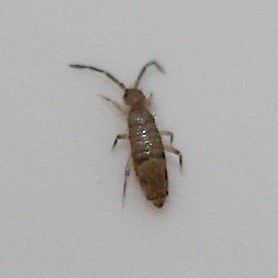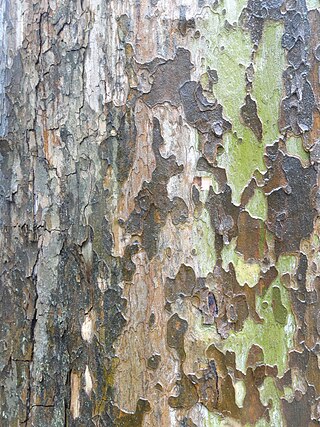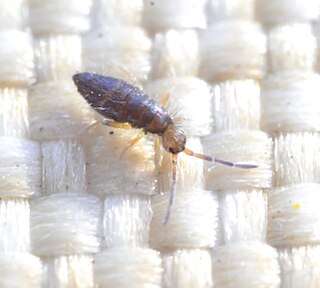
Convolvulaceae, commonly called the bindweeds or morning glories, is a family of about 60 genera and more than 1,650 species. These species are primarily herbaceous vines, but also include trees, shrubs and herbs. The tubers of several species are edible, the best known of which is the sweet potato.

Platanus is a genus consisting of a small number of tree species native to the Northern Hemisphere. They are the sole living members of the family Platanaceae.

Entomobryidae, sometimes called "slender springtails", is a family of springtails characterised by having an enlarged fourth abdominal segment and a well-developed furcula. Species in this family may be heavily scaled and can be very colourful. The scale-less Entomobryidae are commonly caught in pitfall traps around the planet, and also occur in canopy faunas high up in trees. There are more than 1700 described species in Entomobryidae.
Acquaviva Platani is a hill town and comune in the province of Caltanissetta. Its territory, located along the south-north penetration route, along the valleys of the Platani.

Casteltermini is a comune (municipality) in the Province of Agrigento in the Italian region Sicily, located about 70 kilometres (43 mi) southeast of Palermo and about 25 kilometres (16 mi) north of Agrigento.

Cianciana is a comune (municipality) in the Province of Agrigento in the Italian region Sicily, located in the middle valley of the Platani river, about 70 kilometres (43 mi) south of Palermo and about 25 kilometres (16 mi) northwest of Agrigento. The Monte Cammarata, elevation 1,579 metres (5,180 ft) above sea level, part of the Monti Sicani chain, is nearby.

San Biagio Platani is a comune (municipality) in the Province of Agrigento in the Italian region Sicily, located about 70 kilometres (43 mi) south of Palermo and about 20 kilometres (12 mi) north of Agrigento. As of 31 December 2004, it had a population of 3,689 and an area of 42.4 square kilometres (16.4 sq mi). San Biagio Platani is famous for its "Easter Arches"

Neochlamisus platani is a species in the leaf beetle genus Neochlamisus. This beetle feeds, mates, and oviposits on their host plant American sycamore, where it prefers young trees. Its common name is the sycamore leaf beetle for this reason.
Stigmina platani-racemosae is a fungal plant pathogen in the family Mycosphaerellaceae.

Willowsia nigromaculata is a member of the family Entomobryidae. It has a metallic iridescent body and is covered in translucent scales. It is often found indoors in places such as houses, garages and greenhouses.
Sappinia pedata is a free living amoeboid organism, first described by Pierre Augustin Dangeard in 1896. It belongs to the genus Sappinia within the Thecamoebida clade of Amoebozoa and is characterized by its unique monopodial locomotion and cell surface morphology. S. pedata has been found in various habitats worldwide, mostly on herbivore dung, decaying plant matter, and soil. The species has gained attention due to its potential medical relevance and has been the subject of most recent and emerging studies in Protistology and Eukaryotic Microbiology as a whole.

Ceratocystis platani is a fungus that causes a disease on plane trees in the genus Platanus, mostly in North America and Southern Europe.
Tinocallis platani is a species of aphids in the subfamily Calaphidinae. It has a nearctic distribution and is found in Europe and North America.

Willowsia is a genus of slender springtails in the family Entomobryidae. There are about six described species in Willowsia.

Reuteria is a genus of plant bugs in the family Miridae. There are about 15 described species in Reuteria.
Chilocorus orbus is a species of lady beetle in the family Coccinellidae. It is native to North America. It is a black, domed beetle with two large red spots and is commonly called the twice-stabbed lady beetle or the two-stabbed lady beetle. Both adults and larvae feed on scale insects.
Reuteria platani is a species of plant bug in the family Miridae. It is found in North America.

Willowsia buski, the damp grain springtail, is a species of slender springtail in the family Entomobryidae. It is found in abundance throughout North America and Europe, and likely has a cosmopolitan distribution. It can sometimes be found infesting stores of dry goods that have become contaminated with high moisture, giving rise to the name "damp grain springtail".
Animal Ethics is a nonprofit organization formed to promote discussion and debate around issues in animal ethics and to provide information and resources for animal advocates. They also do outreach work in several countries on the issue of speciesism. Their aim is to create a world where moral consideration is extended to all sentient beings. The organization's website covers topics such as speciesism, sentience, veganism and wild animal suffering and has content translated into several languages.

Erysiphe platani, also known as sycamore powdery mildew, is a fungus native to North America that now infects sycamore tree species worldwide. Infections may spread rapidly in urban settings with large groups of young trees or in plant nurseries. This mildew thrives when there are high humidity conditions during the growing season.












